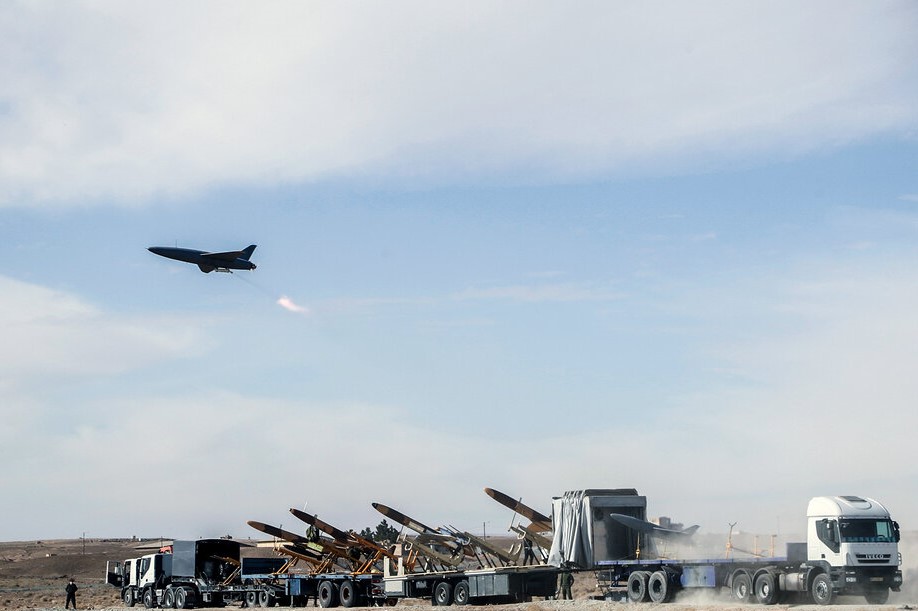The long-range suicide drones of Iran destroyed a predetermined target in a training area over a distance of 1,400 km, on the final day of the large-scale drone military exercise, on January 6.
This first large-scale drone drill of Iran’s Army kicked off in the north-central province of Semnan on January 5 with the participation of hundreds of domestically-produced UAVs (unmanned aerial vehicle) of the Army’s Ground Force, Air Force and Navy. As part of the drill, a kamikaze drone was launched off the coasts of Makran in the south of the country and managed to hit the target 1,400km away in Semnan.
“With the efforts made in Army of the Islamic Republic of Iran, the flight duration of the army's suicide drones has been continuously increased up to 2,000 kilometers with 4,000 kilometers of threats,” Spokesman of the drone combat exercise and Deputy Chief of Operations of Iran's Army Admiral Mahmoud Mousavi said, adding that proportionate operational plans have been predicted for all air, land and sea threats.
The drones were engaged in the pilotless operation, combat, interception, detection, surveillance and suicide bombing. The displayed UAVs, enjoying various kinds of combat and logistic multi-rotors, are capable of launching operations under electronic war conditions and are also equipped with jamming systems and deception radars.
Ground quadcopters destroyed their surface target by releasing small bullets during the two-day drills. In addition, the application of unmanned tactical micro-birds to identify and send images online to control and command centers was another mission of this exercise. Collective flight of drones using artificial intelligence was also performed.
Iran’s Army has also tested a domestic suicide drone dubbed “Arash” for the first time in a military drill. The Army also tested vertical take-off drones capable of carrying lightweight bombs.
The Ababil drones equipped with Almas air-to-surface and precision-guided missiles destroyed hypothetical surface targets during massive aerial drills as well. The Almas missile which has been made by Iranian experts is able to destroy targets on the ground with great precision.
The home-grown Karrar-class interceptor drone of Iran’s Army Air Defense Force has carried out air interception operations and destroyed aerial targets with a low radar cross-section and at high altitude through firing an “Azarakhsh” (Thunderbolt in Persian) air-to-air missile. This is the first time the missile is being used in a war-game. The hypothetical targets were annihilated by Karrar-class drones carrying a 500-pound bomb.
The destruction of surface targets, fortifications, and enemy positions with recurring drones, equipped with MK-82 bombs, was carried out. Monitoring and safeguarding the country's borders was also implemented through a variety of surveillance cameras, reconnaissance and electronic data collection systems.
Iran’s Army Chief Commander Major General Abdolrahim Mousavi said on the second day of the exercise that the military drill is a warning to enemies to avoid any miscalculations.
“Only a small part of Iran’s drone capabilities has been demonstrated in the drill and the Armed Forces of the Islamic Republic of Iran are equipped with advanced drones,” he added.
He said that Iran determines the time and place of the hard revenge for the assassination of Lt. General Soleimani, adding that the strategic goal of the hard revenge is to expel US forces from the region.
Iran has developed a large domestic arms industry in the face of international sanctions and embargoes barring it from importing many weapons. The Iranian military industry has also gained achievements in manufacturing drones whose all parts are produced by the Army’s Ground Forces. Many of them have the ability to evade detection by radar and can deal with a variety of targets.
The Iranian Army has conducted drone drills at a time of heightened tensions with the US. On January 4, President Donald Trump directed acting Defense Secretary Christopher Miller to return the aircraft carrier USS Nimitz and its carrier strike group to the Middle East, reversing Miller's decision to bring the carrier home.
“Due to recent threats issued by Iranian leaders against President Trump and other government officials, I have ordered the USS Nimitz to halt its routine redeployment,” Miller said in a statement.
Between 2015 and 2019, Iran annually spent 4 percent to 5 percent — or $18 billion to $22 billion — of its gross domestic product (GDP) on defense. Defense spending was around $18.4 billion in 2019, according to the US Institute of Peace.







 Azerbaijan and Armenia started the process of demarcation of their border on Tuesday, with the installation of the first border markers based on ge...
Azerbaijan and Armenia started the process of demarcation of their border on Tuesday, with the installation of the first border markers based on ge...
 President Aliyev emphasized the critical role of the North-South Transport Corridor in fostering transport cooperation between Azerbaijan and Russi...
President Aliyev emphasized the critical role of the North-South Transport Corridor in fostering transport cooperation between Azerbaijan and Russi...
 Armenian sappers commenced on Monday mine-clearance operations in the territories adjacent to the Saint Mary Church in village of Voskepar (Armenia...
Armenian sappers commenced on Monday mine-clearance operations in the territories adjacent to the Saint Mary Church in village of Voskepar (Armenia...
 Russian Foreign Minister Sergei Lavrov has reasserted that Moscow has no intentions to stop the fighting in Ukraine, even if peace talks commence.
Russian Foreign Minister Sergei Lavrov has reasserted that Moscow has no intentions to stop the fighting in Ukraine, even if peace talks commence.



